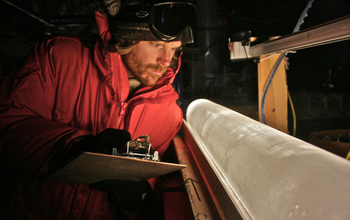Multimedia Gallery
Examining ice core from West Antarctic Ice Sheet Divide
Scientists examine an ice core from the West Antarctic Ice Sheet Divide coring site.
More about this image
Research by scientists from Oregon State and Harvard universities, who used data from 73 ice and sediment core-monitoring sites around the world to reconstruct the Earth's temperature history back to the end of the last ice age, revealed that the planet today is warmer than it's been during 70 to 80% of the last 11,300 years.
Shaun Marcott of OSU, who was lead author on a paper published about the research, says that previous research on past global temperature change has largely focused on the last 2,000 years. By extending the reconstruction of global temperatures back to the end of the last ice age, researchers can put today's climate into a larger context.
"We already knew that on a global scale, Earth is warmer today than it was over much of the past 2,000 years," says Marcott. "Now we know that it is warmer than most of the past 11,300 years."
"The last century stands out as the anomaly in this record of global temperature since the end of the last ice age," says Candace Major, a program director in the National Science Foundation's Division of Ocean Sciences. The research was funded by the Paleoclimate Program in NSF’s Division of Atmospheric and Geospace Sciences.
"This research shows that we've experienced almost the same range of temperature change since the beginning of the industrial revolution," says Major, "as over the previous 11,000 years of Earth history -- but this change happened a lot more quickly."
To learn more about this research, see the NSF news release Earth is warmer today than during 70 to 80 percent of the past 11,300 years. (Date image taken: 1990s; date originally posted to NSF Multimedia Gallery: Oct. 24, 2017)
Credit: Thomas Bauska, Oregon State University
See other images like this on your iPhone or iPad download NSF Science Zone on the Apple App Store.
Images and other media in the National Science Foundation Multimedia Gallery are available for use in print and electronic material by NSF employees, members of the media, university staff, teachers and the general public. All media in the gallery are intended for personal, educational and nonprofit/non-commercial use only.
Images credited to the National Science Foundation, a federal agency, are in the public domain. The images were created by employees of the United States Government as part of their official duties or prepared by contractors as "works for hire" for NSF. You may freely use NSF-credited images and, at your discretion, credit NSF with a "Courtesy: National Science Foundation" notation.
Additional information about general usage can be found in Conditions.
Also Available:
Download the high-resolution JPG version of the image. (817.0 KB)
Use your mouse to right-click (Mac users may need to Ctrl-click) the link above and choose the option that will save the file or target to your computer.

